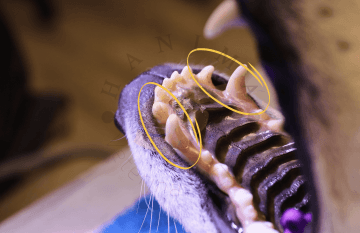Enamel defects
Professional Dental Consultation
The first step before any dental procedure with us is always a professional dental consultation, also known as a dental examination. Without this, we are unable to determine the type, extent, or cost of the necessary dental or dental surgical procedure. We strive to approach our clients transparently to ensure that it is entirely clear what needs to be done and how much it will cost.
The price for a professional dental consultation is 940 CZK.
Enamel and its development and importance:
Enamel is the hardest substance in the body and covers only the crown of the teeth (cementum does the same thing at the root of the tooth). Enamel is 99% inorganic and its task is to protect the underlying dentin. Even before the tooth itself cuts through the gum, on its surface are special cells called ameloblasts, which are responsible for the formation and enamel. Once the tooth has erupted (erupted), these cells are no longer present and enamel development is complete. This results in the enamel no longer being able to repair itself. The enamel provides a hard, smooth, impermeable and protective cover to the crown. If it breaks, the underlying dentin is exposed. The latter is rougher on the surface than enamel, allowing the plaque to adhere quickly and become discolored. Dentin is less hard than enamel (but still harder than bone) and contains tubules that allow contact between the external environment and the pulp of the tooth, and also contains sensory nerve endings from the cells in the pulp - this results in the sensitivity of the teeth to heat and cold. The tubules can also allow bacteria to enter the pulp from the mouth, causing infectious pulpitis.
What is the difference between enamel hypoplasia and hypocalcification?
Enamel developmental defects can be divided on the basis of quality and quantity.
Hypocalcification (impairment of enamel quality) - a normal amount of enamel is formed, but it contains less minerals, so the enamel is softer than normal. It is often possible to remove hypocalcified enamel using ultrasound during tooth brushing.
Hypoplasia (impairment of the amount of enamel) - the enamel is much thinner than usual and there may be pits on the surface.
Both types of defects can be found at the same time and it is not necessary to distinguish them, because therapeutically the approach is the same.
What causes enamel hypoplasia and hypocalcification?
Enamel hypocalcification can be the result of trauma to an unerupted tooth, which can affect one or several adjacent teeth and is the most common acquired cause - it is often associated with unprofessional extraction of persistent milk teeth.
Enamel hypoplasia can result from an inherited condition known as amelogenesis imperfecta. In these cases, almost all teeth are affected.
Serious systemic infectious diseases, such as distemper virus infection, can also lead to improper enamel formation.
Is there a treatment and what should it meet?
Treatment goals include:
Removal of tooth sensitivity
Prevention of endodontic infection by closure of dentinal tubules
Smoothing the tooth to reduce plaque build-up
Composite replacement is the most effective way to achieve these goals. For minor defects or non-strategic teeth, the application of only sealer (bond) can be considered. This achieves the closure of the dentinal tubules and thus the removal of sensitivity and prevention of endodontic infection. Another option is extraction, but it is generally not recommended.
Attrition and abrasion are terms used to describe the wear of tooth enamel, each with distinct causes and characteristics. Both conditions can lead to a loss of the protective enamel layer, increasing the risk of tooth sensitivity, infections, and other dental issues.
Difference Between Attrition and Abrasion
Cause: Attrition is caused by tooth-to-tooth contact, while abrasion is caused by interaction with an external object.
Appearance: Attrition typically has a smooth, uniform appearance, whereas abrasion is irregular and often localized to certain teeth.
Attrition of Enamel
Attrition (from the Latin attritio) refers to mechanical wear of teeth caused by tooth-to-tooth contact.
When it occurs:
Most commonly associated with malocclusion, where abnormal tooth alignment leads to improper friction between teeth.
It can also result from natural aging, as long-term use of teeth causes gradual wear.
Typical appearance:
Attrition usually presents as smooth, evenly worn surfaces on the affected teeth.
Abrasion of Enamel
Abrasion (from the Latin abrasio) refers to mechanical wear caused by external factors.
When it occurs:
Typically results from repetitive contact of teeth with hard objects, such as toys, bones, cages, or other surfaces that dogs chew on.
It can also be caused by inappropriate chewing habits, such as excessive gnawing on unsuitable materials.
Typical appearance:
The wear is often irregular, sometimes with sharp edges, and localized to specific teeth (e.g., canines or incisors) that come into contact with the object.
Consequences and Treatment
Both conditions can result in thinning or loss of enamel, increasing the risk of damage to the dentin and infections in the pulp.
Treatment: A veterinary dentist may recommend protecting the affected teeth with fillings, fluoride treatments, or, in severe cases, endodontic therapy (e.g., root canals).
Prevention: Preventative measures include managing inappropriate chewing habits, maintaining proper oral hygiene, and scheduling regular dental check-ups with a veterinarian.
Understanding the difference between attrition and abrasion helps identify the underlying cause of the issue and ensures the appropriate approach to treatment and prevention.















